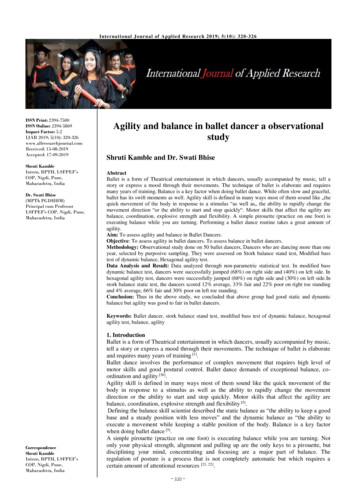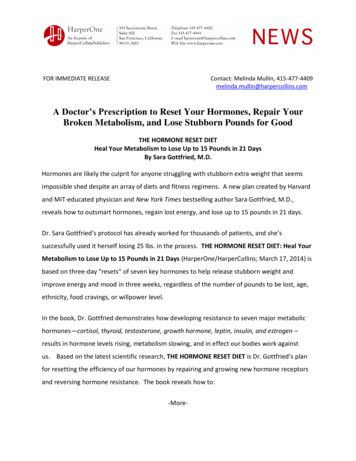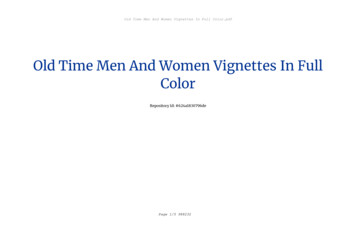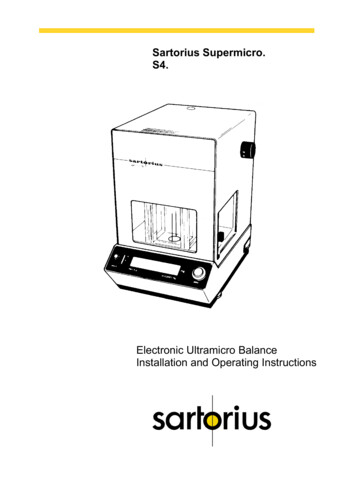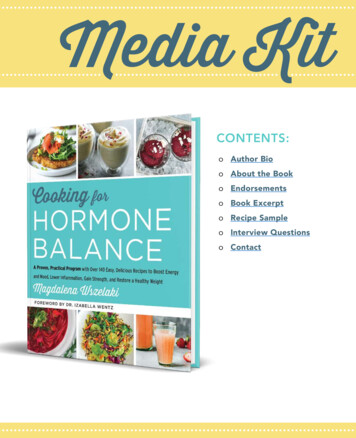
Transcription
Media itCONTENTS:o Author Bioo About the Booko Endorsementso Book Excerpto Recipe Sampleo Interview Questionso Contact
About MagdalenaCooking for Hormone Balance: The founderof the popular Hormones Balance onlinecommunity, holistic nutrition coach, MagdalenaWszelaki knows this firsthand. Developinghyperthyroidism and then Hashimoto’s, adrenalfatigue and estrogen dominance, propelled herto leave a high-pressure advertising career anddevelop a new way of eating that would repairand keep her hormones working smoothly.Now symptom free, Magdalena shares herpractical, proven knowledge so other womenmay benefit. In Cooking for Hormone Balance,she draws on current research to explainthe essential role food plays in keeping ourhormones in harmony and offers easy, flavorfulrecipes to help us eat our way to good health.She also offers clear, concise action plans forwhat to remove and add to our daily diet toregain hormonal balance, including guides forspecific conditions.Join me in discovering how to turn your hormonesinto your best allies.
About the BookMillions of women suffer from symptoms caused by hormone imbalance such as digestive issues, weightgain, anxiety, and mood swings. They are often told there is nothing they can do about it apart from takingbirth control or supplements. Magdalena Wszelaki shows us how to eat our way toward hormone balanceby addressing the foundations of hormonal health in the gut and liver and by stabilizing sugar levels.An integrative hormone and nutrition expert and founder of a nutrition practice, Magdalena Wszelakisuffered from a range of frustrating symptoms and found her way free of them by making specific changesto her diet. In COOKING FOR HORMONE BALANCE: A Proven, Practical Program with Over 125 Easy,Delicious Recipes to Boost Energy and Mood, Lower Inflammation, Gain Strength, and Restore a HealthyWeight (HarperOne; April 2018; Hardcover), she provides a comprehensive, research-backed, personalizedguide to listening to your body and using food to rebalance your hormones.Drawing on her own health journey with hyperthyroidism and Hashimoto’s and as a Certified Health Coachwho has helped thousands of private clients, Magdalena Wszelaki provides recipes and tools for womento take charge of their hormones and:oDetermine what to remove and what to add to our daily dietoBoost energy, reduce inflammation, gain strength, lower stress levelsoHelp to resolve weight gain, depression, anxiety, and mood swingsoProvide nutritional support to your body and restore hormonal balance.Armed with real testimonials, clear action plans, and 125 recipes full of hormone-supporting superfoods,COOKING FOR HORMONE BALANCE explains how food plays an essential role in our hormonal healthand shows women how to reverse hormone-related conditions. Magdalena Wszelaki is available forinterviews. Thank you for considering this exciting new cookbook for coverage in April 2018.Courtney NobleDesk: 212.207.7127courtney.nobile@harpercollins.com
Endorsements“While the recipes are showstoppers, Cooking forHormone Balance also includes many of Magdalena’sinnovative, targeted protocols for specific conditions.You will love her hormone balancing seed rotationprotocol. My clients who have followed it reportbetter moods, fewer hormonal acne breakouts, andnormalized menstrual cycles.”—IZABELLA WENTZ, PharmD, FASCP#1 New York Times Bestselling Author,Hashimoto’s Protocol“In this beautiful healing toolkit, Magdalena helpsus with both the understanding of the true nature ofhormonal balance and the practicalities of how to shiftinto vibrancy and vitality quickly and completely.Cooking for Hormone Balance is absolutely the mostdelicious medicine we could ask for.”—KELLY BROGAN, MD, New York Timesbestselling author of A Mind of Your Own“Cooking for Hormone Balance empowers womenwith the science behind how food can help balancehormones, and an abundance of simple, delectablerecipes that will become every day go-to meals.”—JJ VIRGIN, CNS, CHFS, New York Timesbestselling author of The Virgin Diet andSugar Impact Diet“It is no secret that you can only lose weight if yourhormones are in balance. Magdalena shows you howto identify which of your hormones may need helpand shares her plan, including simple and deliciousmeals, to help get them back in line, including optionsfor paleo dieters.”—ALAN CHRISTIANSON, NMD, New YorkTimes bestselling author of The AdrenalReset Diet“Our daughters are now experiencing hormonalchallenges at much younger age that we have. Thisbook is a must-get to help women reclaim their sacredhormonal balance.”—AMY MYERS MD author of the NewYork Times bestsellers The AutoimmuneSolution and The Thyroid Connection“There are great books on women’s hormonal issuesbut very few provide recipes like Cooking for HormoneBalance. It’s time to rebalance your hormones withyour fork!— SARA GOTTFRIED MD, New York Timesbestselling author of The Hormone Cure,The Hormone Reset Diet, and Younger“Hormone imbalances are often a root cause ofBreast Cancer and many other dis-eases. Cookingfor Hormone Balance provides a solution bydeliciously making food your medicine. Theserecipes are easy to prepare and tantalize yourtaste buds!”—DR. VERONIQUE DESAULNIERS, authorof Heal Breast Cancer Naturally andfounder of BreastCancerConqueror.com4COOKIN G FO R H O R M O N E B AL AN C E - END O RS E M E N T S
Take our onlinequiz to understandif you have ahormonal imbalance:www.hormonesbalance.com/quizChapter 1The ABCs of HormonesYour hormones are responsible for how youthink, feel, and look. A woman with balancedhormones is sharp and upbeat, with a goodmemory. She feels energetic without cafeineduring the day, falls asleep quickly, and wakesrefreshed. She is blessed with a healthy appetite and maintains a desired weight with agood diet. Her hair and skin glow. She feelsemotionally balanced and responds to stresswith grace and reason. When menstruating,her menses comes and goes with no or littlePMS. She has an active sex life. She can maintain a full-term pregnancy. When enteringperimenopause or menopause, she slides intoa new phase of life with ease.If that doesn’t describe you, your hormones are imbalanced. Don’t despair. Youare not alone. Millions of women experiencehormonal imbalance. he good news is, youcan rebalance your hormones naturally andresolve your symptoms.Most conventionally trained doctorstell us that the only way to control our hormones is by taking birth control pills, undergoing hormone replacement therapy, applyingcreams, or even removing our organs, such asthe uterus. I want you to know that these arenot your only options. here are gentle andself-honoring methods for taking care of yourbody that will bring about the sacred balanceyou so deserve.I know that your doctor has probablynever explained the key role of the digestive tract, sugar balance, the liver, or food inrebalancing your hormones. he reasons arenumerous, but still inexcusable. For one, doctors receive only a few hours of clinical training in nutrition and no education at all on thecritical role of the gut in your overall health.Medical training also does not connect thedots from the health of the liver and sugarlevels to overall hormonal balance. If that isn’t
disturbing enough, one of my colleagues, aHarvard-educated doctor, said that using foodas medicine “isn’t sexy enough” when compared to inventing the next celebrated drug.Given the medical establishment’s perspective, it is high time we acknowledge that wehave a personal responsibility to regain andmaintain our health.Whatever your reason for choosing thisbook, I’m so glad you are here. You are openminded, proactive, smart, and resourceful.You refuse to see a pill as the only answer. Ihope you share what you learn here with atleast three other women you love and respect.She can be your mother, your daughter, yourco-worker, or your friend. She can be someoneyou barely know but you can see she’s struggling. Together, we can have an incredibleimpact on the healing of women everywhere.In this book, you’ll learn how you can achievethis without pills, magic potions, or gimmicks.When one hormone is out of sync, it throwsof your other hormones and even other bodysystems.For example, think of a time when youexperienced a lot of stress. Your adrenals werebusy releasing a lot of the hormone cortisol tohelp your body to deal with it. It’s likely thatyour immune system became compromisedby that excessive cortisol release and youcame down with a nasty cold. And it’s likelythat weeks or months ater that, you startedshowing symptoms of low thyroid function(such as hair loss, weight gain, or fatigue) orestrogen dominance (PMS, water retention,or miscarriages).It may feel overwhelming to realize thatmany of your hormones could be out of balance, but the good news is that all of yourhormones can be balanced to a large degreewith a healthy gut, stable sugar levels, and aclean liver.WHAT ARE HORMONES?Key Hormone-Producing GlandsHormones are tiny chemical messengersproduced by a network of endocrine glands,including the pituitary, adrenal, thyroid, andpineal glands; the pancreas; ovaries in women;and testes in men. Hormones are releaseddirectly into the bloodstream and carried tothe organs and tissues of the body to performtheir functions. Excess fat cells can also produce hormones such as estradiol or leptin.Hormones do not exist in isolation. heywork together like musicians in an orchestra.Thyroid gland. his is your body’s gas pedal.It produces hormones that are responsible foryour metabolism, conversion of fat to energy,body temperature, mental functions, and hairand skin quality. Underactive thyroid (hypothyroid) conditions are more common thanoveractive thyroid (hyperactive) conditions.Ninety percent of cases of both conditions (indeveloped countries) result from autoimmunediseases: Hashimoto’s disease causes hypothyroidism, and Graves’ disease causes hyperthy-2COOKIN G FO R H O R M O N E B AL AN C E B O N U S M AT E RI A L S
(because of a weaker immune system), havesugar cravings, and experience low energy.Stressed adrenals also underproduce aldosterone, a hormone that stabilizes your bloodpressure and causes water retention, makingyou feel light-headed and pufy.roidism. herefore, to treat any type of thyroidissue, it is essential to heal the immune system(to stop the immune system’s attack on thethyroid) and not the thyroid alone.Adrenal glands. he adrenals are responsible for producing hormones that manage thestress response and regulate sugar levels, theimmune system, water retention, and bloodpressure. Cortisol is one of the main hormonesproduced by the adrenals. A person living inconstant stress will eventually exhaust theadrenals so much so that the glands are unableto produce suicient cortisol and aldosterone.his can cause you to get sick all the timeOvaries. hese are our prime reproductiveglands. hey produce eggs for fertilizationand the reproductive hormones estrogenand progesterone. In menopausal women,the ovaries stop producing the hormones. Inmenstruating women, a common problem ispolycystic ovaries, an imbalance we discusslater in this chapter.Steroid hormone productionAs you can see, one hormone imbalance affects many oneTestosteroneEstradiolAromatizationCortisolCH A P T E R 1 : T H E A BCS O F H O RM O N E S3
Let’s take a closer look at the hormones thatthese glands produce and their interrelationships.STEROID HORMONESSteroid hormones are a type of hormonederived from cholesterol. his waxy, fatlikesubstance found in all cells of the body travelsthrough your bloodstream in small packagescalled “lipoproteins.” here are two kinds oflipoproteins: low-density lipoproteins (LDL)and high-density lipoproteins (HDL). LDLcholesterol is sometimes called “bad” cholesterol because a high LDL level can causeclogged arteries. HDL cholesterol, or “good”cholesterol, is vital to hormonal balancebecause this is what the steroid hormones aremade of. Women with low HDL (less than60 mg/dL) who follow a low-fat diet tend todevelop hormonal problems.Steroid hormones include the following:Pregnenolone. A critically important steroid hormone produced in the adrenals, sexorgans, brain, and spinal cord that is thesource of progesterone, cortisol, dehydroepiandrosterone (DHEA), testosterone, andestrogen.Progesterone. A steroid hormone produced by the corpus luteum of the ovary (andadrenals when the ovaries are missing). As thename implies, it’s a pro-gestation hormone4that allows women to get pregnant and maintain a full-term pregnancy. It is essential innonpregnant women too because it helps youto stay calm, clear-headed, fall asleep easily,and feel balanced. Progesterone and estrogenare like two dance partners: A good balancebetween these two is vital.Cortisol. A steroid hormone produced bythe adrenals that influences many of thechanges that occur in the body in response toemotional, physical, spiritual, or toxic stress.When you live in a state of chronic stress, yourcortisol levels are constantly elevated, whichcan lead to adrenal fatigue.DHEA (dehydroepiandrosterone). Asteroid hormone produced by the adrenals.It is the precursor hormone to testosteroneand all of the estrogens. DHEA levels in thebody begin to decrease ater age thirty anddecrease more quickly in women. DHEAis oten touted as the “antiaging” hormonebecause both testosterone and estrogen arecritical for women to feel physically strongand mentally sharp, and to have their jointsand vaginas lubricated. Women with adrenalfatigue oten experience low DHEA (hencesymptoms of low estrogen and testosterone),so it is vital in the case of low DHEA to support the adrenals.Testosterone. A steroid hormone and theprimary male sex hormone. In women it isCOOKIN G FO R H O R M O N E B AL AN C E B O N U S M AT E RI A L S
produced in the ovaries and adrenal glands.As much as testosterone is associated withbeing the “male” or “aggressive” hormone,women need it in smaller amounts to feel andlook good. Testosterone gets converted to allthree estrogens, so adequate amounts of thishormone are necessary to maintain optimalestrogens levels.Estrogens. A group of steroid hormones andthe primary female sex hormones that give usboobs, butts, and periods. Produced largely bythe ovaries, some estrogens can also be produced by visceral fat or the adrenals (this isespecially the case when the ovaries have beenremoved). here are three forms of estrogensthat play very diferent roles:Estrone (E1) is the “weaker” estrogen that ishigher in pregnant and menopausal women.Estradiol (E2) is oten called the “antagonistic estrogen,” and many women tend to havean excess of it. he synthetic version is foundin skincare and house-cleaning products. It ishighest in premenopausal women and is theleading cause of estrogenic breast, ovarian,uterine, thyroid, and lung (in nonsmokers)cancers.Estriol (E3) is the “protective” estrogen, contributing to healthy and youthful skin, keepingthe vagina moist and lubricated, and preventing hot lashes and night sweats. Estriol alsohas an anticarcinogenic role.NONSTEROID HORMONEShese are a few of the most important nonsteroid hormones:Thyroxine (T4) and triiodothyronine(T3). he T4 produced by the thyroid can’t bedirectly used by the body until it’s convertedto the active T3 hormone because the conversion happens mainly in the gut and liver.he amount of energy you have, your body fat,mental alertness, and the quality of your hair,skin, and nails depend on the availability ofthe T3 hormone.insulin. A hormone made by the pancreas,insulin sweeps sugar from the blood anddelivers it to cells. When a person eats a dailydiet full of sugar and processed carbohydrates(such as lours, cereals, and packaged foods),the insulin receptors in the cells eventuallyshut down and won’t accept insulin. his iscalled “insulin resistance” (IR), and nearlyhalf of the U.S. population sufers from it. People with prediabetes and diabetes sufer fromIR. Women with high testosterone and polycystic ovary syndrome (PCOS) oten have IR.leptin. A hormone produced by the body’s fatcells that signals to the brain that you have justeaten, you are full, and it’s time to stop eating.People with leptin resistance don’t get that signal delivered, resulting in obesity or years ofunsuccessful dieting.CH A P T E R 1 : T H E A BCS O F H O RM O N E S5
sBreakfastRaspberryand GreenTea LimeMeltiesGrain-FreePizza—TwoWaysRed Velvet Grain-Free BrowniesRaspberry and Green Tea Lime Melties
Farmer’s ife’s reakfastSugar balancing, liver detoxing, rich in proteinsWhen I lived in California, I visited the local farmers’ market every Sunday. It was my littleritual to honor the start of the week. This recipe was inspired by the formidable womanwho served many of these breakfasts at the market. Feel free to modify the patties byreplacing half of the lamb with ground pork, bison, beef, chicken, or turkey. Experimentwith different herbs, spices, or even fruits that resonate with you and help you to feelenergetically balanced. Perhaps some cumin, nutmeg, and apricots or dried cherries?
To make the patties, in a large bowl, knead togetherthe lamb, fennel seed, apple cider vinegar, coconutaminos, and salt.M A K E S 12 patties(freeze the balance)SERVES2PREP TIMEUsing your hands, form the mixture into twelvepatties.In a skillet over medium-high heat, heat 1½teaspoons ghee. Place six patties in the hot skilletand fry for 4 minutes or until brown. Flip and fry for3 minutes. Set aside. Add the remaining ghee to theskillet and fry the remaining patties.To make the salad, in a medium bowl, toss the greenswith the olive oil, lemon, and salt until well coated.20 minutesCO O K I N G T I M EEQUIPMENT30 minutes11-inch skilletL AMB PAT TIES1 pound ground lamb2 tablespoons groundfennel seed2 tablespoons applecider vinegar2 tablespoons coconut aminos1 teaspoon smoked sea saltTo serve, place half the salad on each plate and topwith two patties and half the avocado, sauerkraut, andpomegranate seeds. Store the remaining patties forthe next day’s breakfast.Patties keeps well in the refrigerator for up to 5 days orin the freezer for up to 3 months.1 tablespoon ghee, dividedSAL AD2 handfuls of greens suchas arugula, mizuna, babykale, or baby spinach2 tablespoons extravirgin olive oilPALEO1 tablespoon freshlysqueezed lemon juiceAIP Replace the fennel seed with thyme or oregano.Dash of sea saltANTI- CANDIDA Avoid Kohlrabi Kraut or sauerkraut for the irst4 weeks of the anti-Candida diet.SIDESLOW FODMAP Eat only ¹ 8 of the avocado per serving, or1 ripe avocado, peeled,pitted, and slicedavoid. Eat no more than 1 tablespoon Kohlrabi Kraut or sauerkrautper day.1 cup kohlrabi kraut (page 275)or store- bought sauerkraut½ cup fresh pomegranate seeds
Raspberry and Green TeaLime MeltiesLow in sugar, antibacterial, high in good fatsWhether you need a satisfying snack in the evening or a quick dessert for a dinner party,these melties have a good chance of becoming a staple in your house, as they are inmine. Make the meltie base and then choose the raspberry or green tea option.MAKES10 meltiesPREP TIME15 minutesCHILLING TIME20 minutesMini- mufinbaking cups or molds, whiskEQUIPMENTMELTIE BASE¾ cup coconut butter1 teaspoon freshly grated limepeel, plus extra to garnish2 tablespoons freshlysqueezed lime juice1 tablespoon raw honeyor coconut syrup½ teaspoon vanilla extract3 tablespoons hotmelted coconut oilPinch of sea salt10 fresh raspberries (forRaspberry Melties)1 teaspoon green matchatea powder (for greenTea lime Melties)In a medium bowl, combine the coconut butter,grated lime peel, lime juice, honey, vanilla extract,coconut oil, and salt and whisk until well combined.he hot coconut oil should soten the coconut butter,but if the coconut butter remains lumpy, microwavethe mixture for 20 seconds and whisk again until asmooth paste is formed.For Raspberry Melties, place one raspberry in eachmini-muin cup and then cover it with slightly lessthan 1 tablespoon of the meltie base.For Green Tea Lime Melties, whisk the green teapowder into the meltie base mixture and scoop slightlyless than 1 tablespoon into each mini-muin cup.Garnish the melties (both kinds) with grated lime peel.Place in the freezer for 20 minutes or until hardened.Serve chilled.Keep in an airtight container in the refrigerator for upto 10 days.3 0 COOKIN G FO R H O R M O N E B AL AN C E B O N U S M AT E RI A L S
PALEOAIPANTI- CANDIDA Replace the honey with six drops of stevia.LOW FODMAP Replace the honey with coconut nectar or Grade B maple syrup.RA S P BE RRY A N D G RE E N T E A L I M E M E LT I E S31
Suggested Questions for MagdalenaoWho is Cooking for Hormone Balance for?ooHow can food rebalance someone’shormones?How much do genetics play a role inhormonal balance?oI hear that flaxseed is estrogenic. Ifsomeone has estrogen dominance, shouldthey avoid it?In your opinion, what role does the gut andthe microbiome (gut bugs) play a role inhormonal balance?oWhat are your 3 favorite hormonebalancing superfoods?You talk about the liver’s role in balancinghormones. Can you elaborate?oWhat foods do you recommend removingooooFor women in peri- and menopause –what 3 tips can you offer to help with thesymptoms?I’m curious about seed rotation – canyou explain how to use it to rebalancehormones?or adding?oWhat was your journey with hormonalimbalances?oHow did you put Hashimoto’s intoremission?oTell us something unique about yourbackground.
Courtney NobileAssociate Director of PublicityHarperOne, an imprint of Harper Collins s.com
—ALAN CHRISTIANSON, NMD, New York Times bestselling author of The Adrenal Reset Diet “Our daughters are now experiencing hormonal challenges at much younger age that we have. This book is a must-get to help women reclaim their sacred hormonal balance.” —AMY MYERS M

